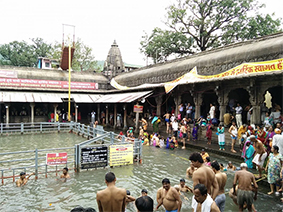Physical Address
304 North Cardinal St.
Dorchester Center, MA 02124
Physical Address
304 North Cardinal St.
Dorchester Center, MA 02124

The Nashik Simhasth, also known as the Nashik Kumbh Mela, is a significant religious event in Hinduism. Here’s a specific feature on the Nashik Simhasth:
1. Distinctive Aspects:
2. Spiritual Significance:
3. Rituals and Ceremonies:
4. Infrastructure and Arrangements:
5. Cultural Exchange and Heritage:
In summary, the Nashik Simhasth is a revered religious event that holds profound spiritual significance for millions of devotees. It embodies the essence of Hinduism’s rich cultural heritage and serves as a symbol of faith, devotion, and communal harmony.
Significance of Trimbak in Kumbh Mela

Trimbak, near Nashik, is home to the Trimbakeshwar Temple, dedicated to Lord Shiva. It houses one of the twelve Jyotirlingas, making it a focal point for Shaivites.
Godavari River: The Godavari, often referred to as the Dakshin Ganga (Ganga of the South), originates here. Pilgrims believe that bathing in the river during the Kumbh Mela washes away sins and liberates them from the cycle of rebirth.
Key Rituals and Events
Shahi Snan (Royal Bath):
Central to the Kumbh Mela, the Shahi Snan sees saints and sadhus of various akharas (Hindu monastic orders) taking a ceremonial dip in the Godavari.
The first Shahi Snan is especially auspicious, with a grand procession featuring religious leaders and devotees.
Spiritual Gatherings:
Discourses by revered saints, kirtans (devotional songs), and meditation sessions attract millions of devotees.
Religious Rites:
Pind Daan (offering for ancestors), havans (fire rituals), and other pujas are performed at the Kushavarta Kund, a sacred tank near the temple.
Processions:
Akharas participate in vibrant processions showcasing traditional music, dances, and rituals.
Cultural and Social Impact
Mass Pilgrimage: The Kumbh Mela at Trimbak is a global attraction, drawing millions of devotees, tourists, and spiritual seekers.
Economic Boost: The influx of visitors significantly benefits the local economy, with increased demand for accommodations, food, and transport services.
Spiritual Unity: The event fosters a sense of collective spirituality and serves as a platform for philosophical and cultural exchange.
Recent Updates
The most recent Kumbh Mela at Trimbak was held in 2015. It was marked by:
Enhanced safety measures and infrastructure improvements.
Efforts to maintain cleanliness under the Swachh Bharat Abhiyan.
Digital innovations for crowd management and pilgrim assistance.
The next Kumbh Mela in Trimbak is expected in 2027, following the traditional 12-year cycle.